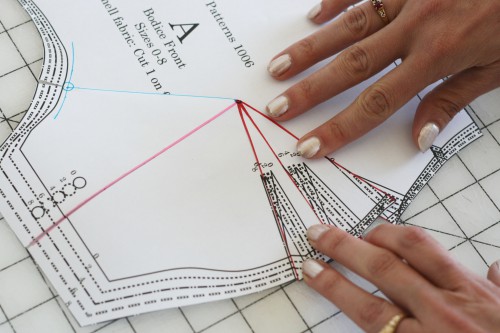
Now that we’ve covered the full bust adjustment, this second part of our Rooibos fit clinic shows you how to make a small bust adjustment, or SBA, for the Rooibos pattern.
How do I know if I need a Small Bust Adjustment?
At this point, you should have a muslin in made up in your size. Try on the muslin and take a close look at the bust area. Does it seem to be sagging around the bust? Are there loose wrinkles around your breasts? Because our patterns are drafted at a C-cup, sewists who are much smaller than that cup size may find a Small Bust Adjustment helpful in getting a better fit.
What is a Small Bust Adjustment?
A Small Bust Adjustment changes the pattern to remove some of the fullness around the bust. It focuses just on the area filled by the curve of your bust, eliminating any excess fabric there.
For a full bust adjustment, check out this tutorial
How to do a Small Bust Adjustment
There are quite a few steps to this tutorial, but have patience! With some time spent working on it, things will come together, we promise.
Tools Needed:
- Rooibos
- your muslin
- Straight ruler
- French curve
- Pen or pencil
- Tape
- Scissors
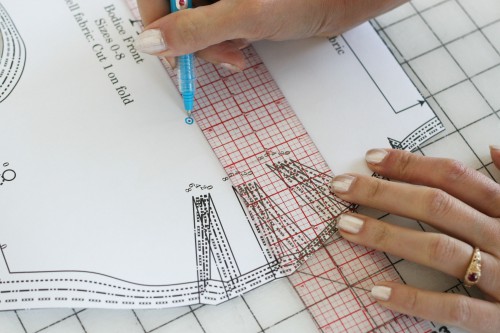
1. At this point, you’ve already tried on your muslin and determined that you need to remove some fabric around the bust. You should have also marked your bust line, bust apex, waist, and hip.
2. When wearing your muslin, pinch out the fullness around the bust and pin. Measure the amount you’ve pinched on each side of the bust, you’ll need this later.
3. Transfer the apex point to the pattern piece. For this SBA we’ve marked the apex by drawing a circle with a dot in the center (photo above).
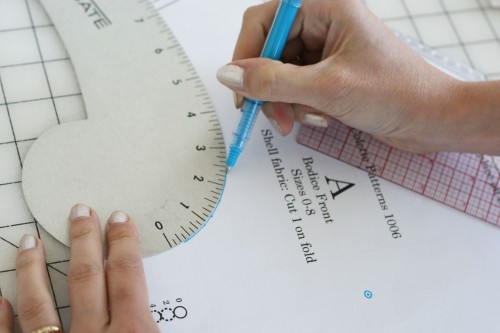
4. Now we’re going to draw in a seam allowance along the deep curve of the armscye. Use a French curve to draw 5/8″ seam allowance just along this part of the curve.
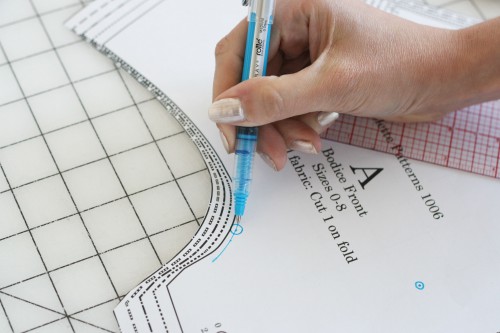
5. Choose a point along this curve and mark it. This will be your pivot point. You can see we’ve marked it with another circle.
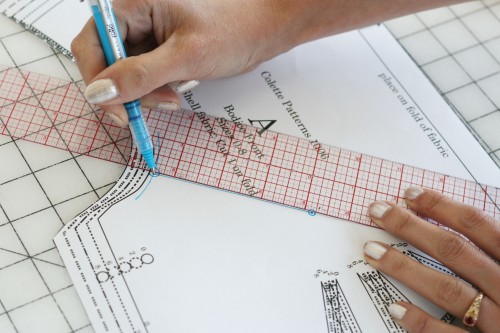
6. Draw a line from the apex point to the armscye pivot point.
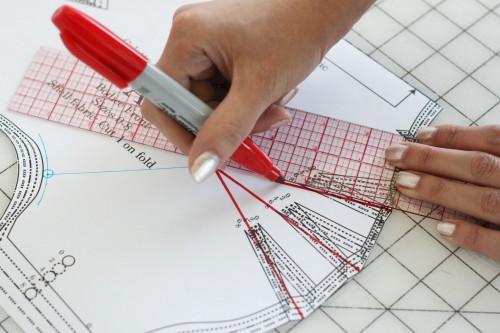
7. Draw lines from the center of each dart to the apex (ours are drawn in red).
Normally, when you do an SBA, you simply draw one line from the dart to the apex. Since we have three darts here, we’re going to remove the fullness evenly amongst all three.
Also, if you can’t get your lines to go right through the tip of the dart, don’t worry! Just start them in the middle of the dart at the seam, and end at the apex point. You’ll be redrawing the darts later.
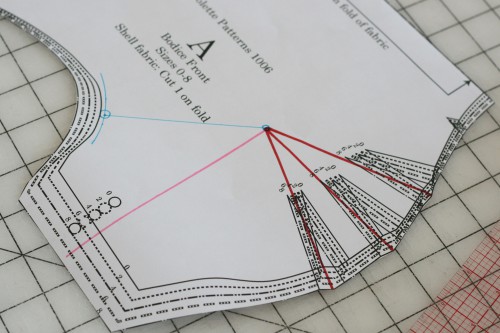
8. Draw a line from the apex point to the side seam. With a ruler make sure that the line is perpendicular to the center front. Your piece should look something like this.
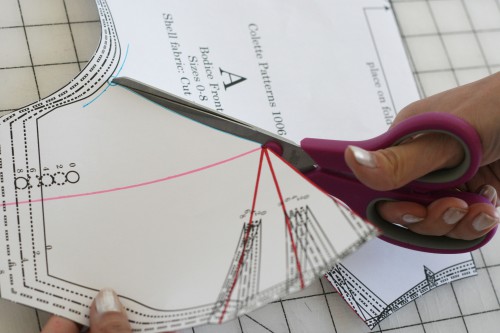
9. Cut along the first dart (red) line, up through the apex, and ending at the armscye point.
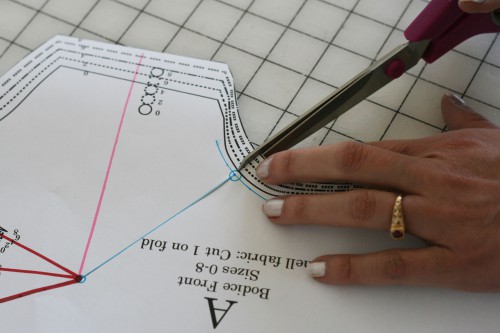
10. Snip the seam allowance to the armscye point. Make sure you leave a hinge by snipping close to the point but not through it.
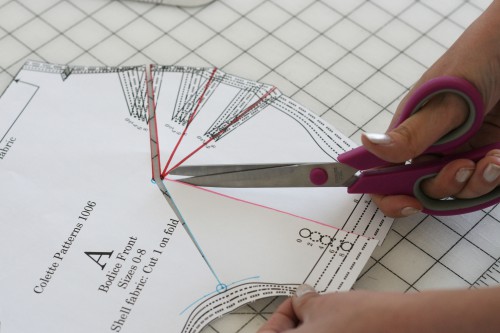
11. Cut the side seam line to the apex. Leave a hinge.
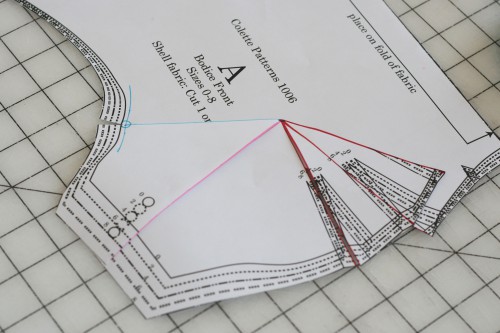
12. Cut the remaining marked dart lines up to the apex point. Leave a hinge.
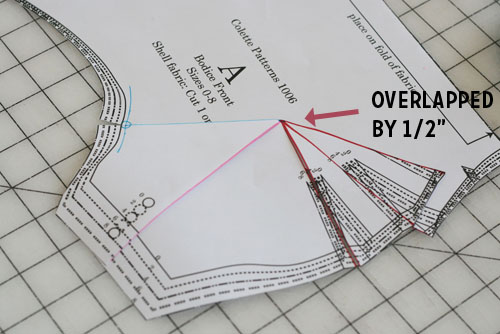
13. Overlap the fullness amount at the apex. For our SBA we used 1/2″. It’s difficult to see in photos, but there is an overlap of 1/2″ at the apex. Tape in place.
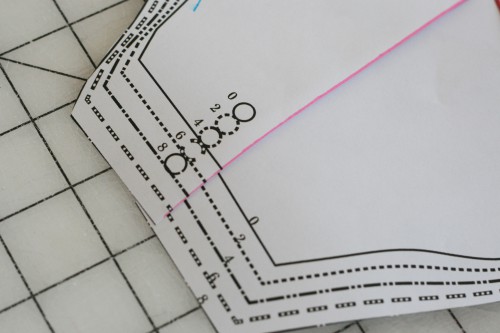
14. Adjust the side seam by allowing the pieces to overlap here slightly. Try keeping the bottom left portion of the pattern stationary, while moving the other pieces to create the overlap at the apex. This should result in an overlap at the side seam as well.
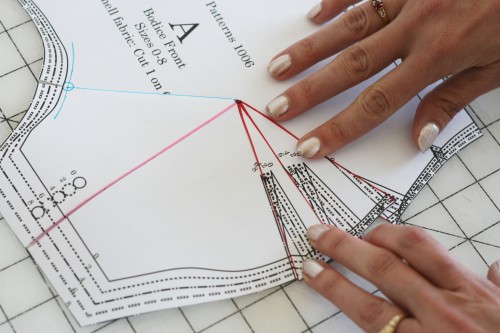
15. Adjust the darts so that they’re about the same width between the legs. The darts should now be a little smaller than before. Tape all openings to hold them in place.
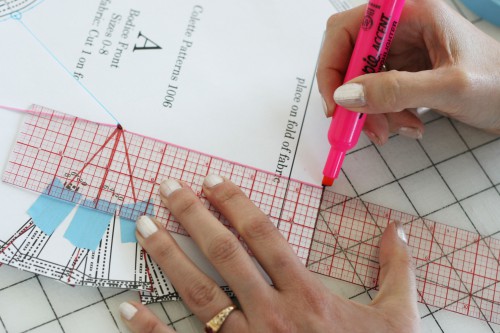
16. Draw a perpendicular line from the center front to the apex. Cut along the line all the way across.
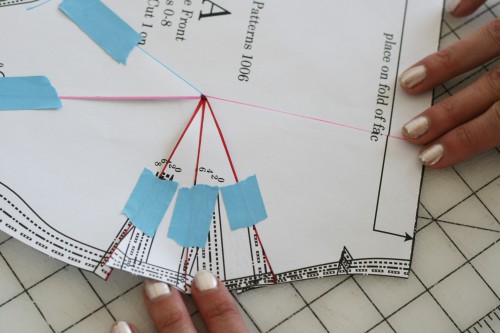
17. Remove the taped dart leg that’s attached to this piece. Now move this free piece up a bit so that the bottom cutting line matches up correctly with the rest of the pattern’s edge.
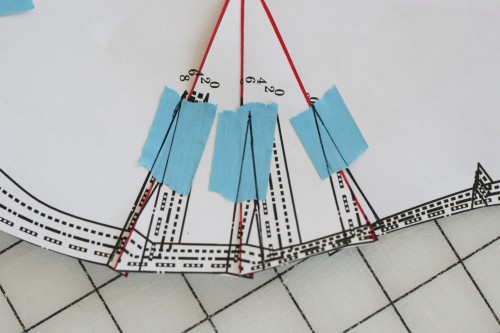
18. Draw new darts by drawing over the current dart lines.
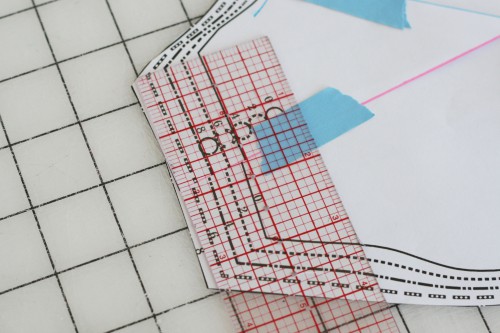
19. Measure the length of the side seam piece at the seam allowance. That means, measure the length 5/8″ from the edge. It should be a little shorter than before because of the overlap.
20. Because you made the front bodice a little shorter, you’ll need to make the back bodice a little shorter too. To do this, simply pinch out a small horizontal fold on the back bodice to remove the same amount that you removed at the side seam. So if you made the side seam 1/4″ shorter, for example, simply make a small fold in the back bodice to remove that 1/4″ all the way across.
Phew! We’re done with the adjustment! Now it’s time to make a muslin of the bodice with your new pattern pieces.
Don’t worry if it doesn’t fit perfectly, it will definitely fit better than before and you’ll have just a little bit of tweaking to do. Getting a great fit takes time and patience.
If you get frustrated, take a break and come back with fresh eyes when you’re ready. It’s easy to feel like your garment will never fit, trust me, I often feel that way at first! But with some changes to your pattern and at least one muslin (often more) made, your garment will be ready to turn into that wonderful dress you’ve imagined.



Comments
Woohoo! I have been wondering how to do this for ages. Thank you so much!
Thanks so much! I really need to do a SBA with Colette Patterns, or wear a very padded bra :-)
oh thanks for the refresher, i always have to do this alteration… and great job on the site redesign!! i LOVE the stitching all along the border, so cute :]
Thanks, Caitlin! I’ve been wondering how on Earth I was going to make Rooibos fit. It shouldn’t be so hard now :D
Thank you for this post. I bogged down in my attempts to make your Crepe dress because I didn’t know how to adjust the bodice. Do you think that what you show here would be adaptable to the Crepe dress?
–C.B. (who is really stupid about alterations)
It would definitely be applicable, though you may have to make a few little changes for the Crepe pattern.
Hi Sarai! Yes, this will definitely help me out too! That’s good to know all your patterns are drafted at a C-cup – this will help me do some adjusting on the Sencha. Is this also a general tip you cover in your new book? ;)
Thanks for the thorough instructions! Hope you have a lovely weekend…
I am baffled by step 13 onward. In step 13, which pieces are you overlapping at the apex? All three wedges coming from the darts? This is where a video would really help!
When I try on my bodice muslin, there is bagginess in the bust area, but it goes away when I pin a generous vertical tuck in the center (5/8″ pinned, so 1 1/4″ overall). But here you describe it as “measure out the amount you’ve pinned on each side of the bust.” Does it matter that my amount came from dead in the middle?
If I need to lose material in the center, is an SBA what I need? Or is that a different type of adjustment?
Thanks!!
I’m rather behind on the sewalong, but I finished my muslin this weekend and then set to work on the SBA. I haven’t tried making the muslin from my revised pattern because it looks so different from the photos above and I have some questions to determine if I did the process properly. (1) How does one determine the Apex and how best is this transferred back to the pattern? (2) What/where are the dart legs?
If I located my apex properly then the darts need to move dramatically as the apex is directly above the centermost original dart, but I’m not really certain how/where to redraw them.
Hi,
I just finished my Rooibos muslin and I will be making a SBA. I also need to take in the waist and hips. How do you think I should alter the pattern to accommodate my requirements. I love he new book by he way and can’t wait to make some of the patterns in it.